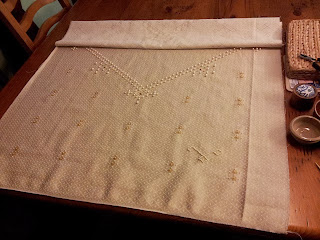Some I used more than others, but all are at least good starting points for further investigations.
14th to 15th Century Soft
Cheese, Cheesemaking, accessed Aug
2013,
http://www.cheesemaking.com/includes/modules/jwallace/onlinenews/feedbackpics/06_11/friends/pics/meidieval.pdf
Asiago, Finica, accessed Sept 2013,
http://www.finica.com/productsDetail.php?Asiago-56
Asiago, Wisconsin Cheese, accessed Aug 2013,
http://www.eatwisconsincheese.com/cheese/article.aspx?cid=4
Austin, T. (1888) Two
Fifteenth-Century Cookery-Books. Harleian MS. 279 & Harl. MS. 4016, with
extracts from Ashmole MS. 1429, Laud MS. 553, & Douce MS 55,
London: for The Early English Text Society by N. Trübner & Co, accessed
Sept 2013,
http://www.archive.org/stream/twofifteenthcent00aust/twofifteenthcent00aust_djvu.txt
Blackie, M. (1994) Farmhouse
Cooking, HarperCollins, NSW.
Bogucki, P.
I. (1984)
Ceramic sieves of the Linear Pottery culture and their
economic implications, Oxf. J. Archaeol.
3, 15–30.
Brien, A, Various,
ChannelCheeseTV, accessed July 2013, http://www.youtube.com/watch?v=2iDIuth93hE
Brand, L (2004) Lime,
accessed June 2013,
http://www.openairclassroom.org.uk/Further%20information/information-lime.pdf
Carroll, R. (2002) Home
Cheese Making, Storey, USA.
Cato, MP and Varro, MT
(100BC) Roman Farm Management - The Treatises of Cato and Varro, Project
Gutenberg, accessed Sept 2013, http://www.gutenberg.org/ebooks/12140
Cennini,
Cennino (1954), The craftsman's handbook : the Italian Il libro dell'arte,
Dover, New York.
Cheese: True (gut) Rennet
vs. Microbial and other types,
Comment: cheesemaestro, accessed Sept 2013,
http://chowhound.chow.com/topics/881320
Cheeses, Rustic Cooking, accessed Aug 2013,
http://www.rusticocooking.com/cheeses.htm
Cheesemaking, Ribe Viking Center, accessed Aug 2013,
http://ribevikingecenter.dk/en/learn-more/food-cheese.aspx
Clarified Butter, Wikipedia, accessed Aug 2013, http://en.wikipedia.org/wiki/Clarified_butter
Copley M.S., Berstan R.,
Mukherjee, A.J., Dudd S.N., Straker V., Payne S. & Evershed R.R (2005) Dairying in
antiquity: III - Evidence from absorbed lipid residues dating to the British
Neolithic, Journal of
Archaeological Science, 32: 523–546.
Cornelii Taciti, P. (98AD) De
Origine Et Situ Germanorum, accessed Aug 2013,
http://www.laurentianum.de/lggerm02.htm
Craig, O & Chapman, J
& Figler, A & Patay, P & Taylor, G & Collins, M. (2003) 'Milk
Jugs' and other Myths of the Copper Age of Central Europe, European Journal
of Archaeology, vol 6(3): 251-265.
Digby, K, The Closet of
Sir Kenelm Digby Knight Opened, accessed June 2013,
http://www.gutenberg.org/ebooks/16441
Grant, M. (2008) Roman
Cookery: Ancient Recipes for Modern Kitchens, Serif, London.
Haloumi, Cyrus Food and Drinks, accessed Sept 2013,
http://www.cyprusfoodndrinks.com/cgibin/hweb?-A=301&-V=b2b
Halloumi, Slow Food Foundation, accessed Sept 2013,
http://www.slowfoodfoundation.com/ark/details/523/halloumi-
Halloumi, Wikipedia, accessed Aug 2013,
http://en.wikipedia.org/wiki/Halloumi
Hard Cheese Recipe
Booklet, Mad Millie,
www.madmillie.com
Hayes, C. (2011) 'Galway
butter find dates back to the Iron Age' Irish Central, accessed Sept 2013,
http://www.irishcentral.com/news/Bog-Butter-find-believed-to-be-2500-years-old-121769889.html
Kindstedt, P. (2012) Cheese and Culture: A history of cheese and its
place in western civilisation, Chelsea Green, USA.
Lorenzi, R. (2009) 3000
Year Old Butter Found in Ireland, NBCnews, accessed Aug 2013,
http://www.nbcnews.com/id/32630695/ns/technology_and_science-science/t/-year-old-butter-discovered-ireland/#.Ue6iLqwpiHy
Mair, V and Hoh, E. (2009) The
True History of Tea, Thames & Hudson, London.
Medieval Cheese, Blogspot, accessed April 2013,
http://medievalcheese.blogspot.com.au/
Medieval Cheese, Facebook, accessed April 2013,
https://www.facebook.com/Medievalcheese
Mendelson, A. (2008) The Suprising Story of Milk Through the Ages,
Alfred A Knopf, New York.
Myrdal, J and Fenton, A,
(1988) The Plunge Churn from Ireland to Tibet: Food and drink and
travelling accessories: In honorem Gosta Berg, Edinburgh, P191-212
Outram, A & Stear, N
& Bendrey, R & Olsen, S & Kasparov, A & Zaibert, V &
Thorpe, N & Evershead, R, (2009) The Earliest Horse Harnessing and
Milking, Science Magazine, vol 323, P1332-1335.
Quicklime, Wikihow, accessed Aug 2013,
http://www.wikihow.com/Make-Quicklime
Scappi,
B., Opera : (dell' arte del cucinare). Reprint. First published: Opera
di M. Bartolomeo Scappi. Venice, 1570. 1981, Bologna: Arnaldo Forni. [20], 436
leaves [ca. 888 p.], [28] p. of plates. translated by Louise Smithson, (Helewyse de Birkestad) February 2011, accessed
July 2013, http://dir.groups.yahoo.com/group/scacooksitalian/message/289
Swaminathan, N (2012) A
Pre-historic Cocktail Party, Archaeological Institute of America, accessed
March 2013, www.archaeology.org
Theophilus P.;Hendrie R.
(1847) An essay upon various arts, in three books, John Murray, London
http://archive.org/details/theophiliquietr01hendgoog
accessed May 2013
Thistle Rennet Cheese, Culture Cheese Mag, accessed Sept 2013,
http://www.culturecheesemag.com/style/spring_2010/thistle_rennet_cheese
Various, Cheese.com, accessed Aug 2013,
http://www.cheese.com/
Visit to an Italian
Asiago Cheese Factory, Recipe Girl
Blog, accessed Aug 2013,
http://www.recipegirl.com/2010/06/09/visit-to-an-italian-asiago-cheese-factory/
Waxing the Round, Essential Stuff, accessed Aug 2013, http://essentialstuff.org/index.php/2011/06/06/Cat/cheese-making-waxing-the-round/




















